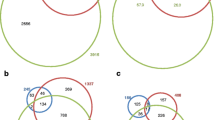Abstract
Although it has been documented that plants generate isothiocyanates (ITCs) through the glucosinolate-myrosinase system to defend against biotic stresses, the roles of ITCs in defending against abiotic stresses have scarcely been studied. Here, we report that exogenously applied ITCs enhance the heat tolerance of Arabidopsis thaliana. Pre-administration of phenethyl ITC to Arabidopsis plants mitigated growth inhibition after heat stress at 55 °C for 1 h. Although methyl ITC and allyl ITC also tended to reduce the growth inhibition that the same heat treatment caused, the reduction effects were weaker. The expression levels of heat shock protein 70 genes in Arabidopsis were elevated after phenethyl ITC treatment. These results suggest that ITCs may act as heat-tolerance enhancers in plants.



Similar content being viewed by others
Abbreviations
- DAG:
-
Days after germination
- GB:
-
Glycinebetaine
- HSP:
-
Heat shock protein
- ITC:
-
Isothiocyanate
- ROS:
-
Reactive oxygen species
- RT-PCR:
-
Reverse transcription-polymerase chain reaction
- SA:
-
Salicylic acid
References
Alia HH, Sakamoto A, Murata N (1998) Enhancement of the tolerance of Arabidopsis to high temperatures by genetic engineering of the synthesis of glycinebetaine. Plant J 16:155–161
Allakhverdiev SI, Kreslavski VD, Klimov VV, Los DA, Carpentier R, Mohanty P (2008) Heat stress: an overview of molecular responses in photosynthesis. Photosynth Res 98:541–550
Chen Z, Silva H, Klessig DF (1993) Active oxygen species in the induction of plant systemic acquired resistance by salicylic acid. Science 262:1883–1886
Chitwood DJ (2002) Phytochemical based strategies for nematode control. Annu Rev Phytopathol 40:221–249
Clay NK, Adio AM, Denoux C, Jander G, Ausubel FM (2009) Glucosinolate metabolites required for an Arabidopsis innate immune response. Science 323:95–101
Dat JF, Lopez-Delgado H, Foyer CH, Scott IM (1998) Parallel changes in H2O2 and catalase during thermotolerance induced by salicylic acid or heat acclimation in mustard seedlings. Plant Physiol 116:1351–1357
Fahey JW, Zalcmann AT, Talalay P (2001) The chemical diversity and distribution of glucosinolates and isothiocyanates among plants. Phytochemistry 56:5–51
Grubb CD, Abel S (2006) Glucosinolate metabolism and its control. Trends Plant Sci 11:89–100
Halkier BA, Gershenzon J (2006) Biology and biochemistry of glucosinolates. Annu Rev Plant Biol 57:303–333
Hall AE (2001) Crop responses to environment. CRC Press LLC, Boca Raton
Hara M, Yatsuzuka Y, Tabata K, Kuboi T (2010) Exogenously applied isothiocyanates enhance glutathione S-transferase expression in Arabidopsis but act as herbicides at higher concentrations. J Plant Physiol 167:643–649
Hopkins RJ, van Dam NM, van Loon JJ (2009) Role of glucosinolates in insect–plant relationships and multitrophic interactions. Annu Rev Entomol 54:57–83
Horváth E, Szalai G, Janda T (2007) Induction of abiotic stress tolerance by salicylic acid signaling. J Plant Growth Regul 26:290–300
Iba K (2002) Acclimative response to temperature stress in higher plants: approaches of gene engineering for temperature tolerance. Annu Rev Plant Biol 53:225–245
Khokon MA, Jahan MS, Rahman T, Hossain MA, Muroyama D, Minami I, Munemasa S, Mori IC, Nakamura Y, Murata Y (2011) Allyl isothiocyanate (AITC) induces stomatal closure in Arabidopsis. Plant Cell Environ 34:1900–1906
Kliebenstein DJ, Kroymann J, Mitchell-Olds T (2005) The glucosinolate-myrosinase system in an ecological and evolutionary context. Curr Opin Plant Biol 8:264–271
Kotak S, Larkindale J, Lee U, von Koskull-Döring P, Vierling E, Scharf KD (2007) Complexity of the heat stress response in plants. Curr Opin Plant Biol 10:310–316
Lee JH, Schöffl F (1996) An Hsp70 antisense gene affects the expression of HSP70/HSC70, the regulation of HSF, and the acquisition of thermotolerance in transgenic Arabidopsis thaliana. Mol Gen Genet 252:11–19
Sakamoto A, Murata N (2002) The role of glycine betaine in the protection of plants from stress: clues from transgenic plants. Plant Cell Environ 25:163–171
Senaratna T, Touchell D, Bunn E, Dixon K (2000) Acetyl salicylic acid (Aspirin) and salicylic acid induce multiple stress tolerance in bean and tomato plants. Plant Growth Regul 30:157–161
Senaratna T, Merritt D, Dixon K, Bunn E, Touchell D, Sivasithamparam K (2003) Benzoic acid may act as the functional group in salicylic acid and derivatives in the induction of multiple stress tolerance in plants. Plant Growth Regul 39:77–81
Wahid A, Gelani S, Ashraf M, Foolad MR (2007) Heat tolerance in plants: an overview. Environ Exp Bot 61:199–223
Winde I, Wittstock U (2011) Insect herbivore counter adaptations to the plant glucosinolate-myrosinase system. Phytochemistry 72:1566–1575
Yan X, Chen S (2007) Regulation of plant glucosinolate metabolism. Planta 226:1343–1352
Zhang Y, Li J, Tang L (2005) Cancer-preventive isothiocyanates: dichotomous modulators of oxidative stress. Free Radic Biol Med 38:70–77
Zhao Z, Zhang W, Stanley BA, Assmann SM (2008) Functional proteomics of Arabidopsis thaliana guard cells uncovers new stomatal signaling pathways. Plant Cell 20:3210–3226
Acknowledgments
This study was supported in part by a Grant-in-Aid (No. 21658025) for Scientific Research from the Ministry of Education, Science, Sports and Culture of Japan.
Author information
Authors and Affiliations
Corresponding author
Electronic supplementary material
Below is the link to the electronic supplementary material.
Rights and permissions
About this article
Cite this article
Hara, M., Harazaki, A. & Tabata, K. Administration of isothiocyanates enhances heat tolerance in Arabidopsis thaliana . Plant Growth Regul 69, 71–77 (2013). https://doi.org/10.1007/s10725-012-9748-5
Received:
Accepted:
Published:
Issue Date:
DOI: https://doi.org/10.1007/s10725-012-9748-5




